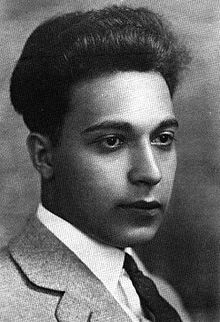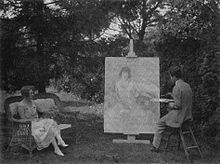- Manuel Azadigian
-
Manuel Azadigian 
Manuel AzadigianBorn October 15, 1901
Malatya, Ottoman EmpireDied September 17, 1924 (aged 22)
Philadelphia, PennsylvaniaNationality American Field Painting Training Pennsylvania Academy of the Fine Arts, Académie de la Grande Chaumière Movement Portraits, Still Life Works "The Russian Poet" (1921-2) Patrons Arshag Karagheusian Influenced by Robert Vonnoh, Daniel Garber Manuel Azadigian (October 15, 1901 – September 17, 1924) was an American painter and sculptor.
Contents
Early life and education
Azadigian was born in Malatya in the Ottoman Empire into a moderately influential family of the village on his mother's side, though his father was a humble farmer. Manuel demonstrated a talent for drawing from his earliest years. By the time of his birth, many of his relatives had already began immigrating to the United States for a better life and to escape persecution they faced as Armenians. His father, George Azadigian, moved to America in 1912 to prepare the way for his wife a two children, who joined him there in June 1912. The Azadigians settled in Philadelphia, Pennsylvania, where his maternal relatives had settled in North Philadelphia, and entered the local public school. He studied there for three years before having to leave school in 1915 at age 13 to help his impoverished family.
Early life and education
After a few years of working, Azadigian was accepted to the Pennsylvania Academy of the Fine Arts where he quickly became one of its best students, finishing the first year of coursework in just two months. These were very difficult times for Manuel, working odd jobs during the day while attending classes at night. He studied painting under the Institute's principal instructor Robert Vonnoh, who later recommended Azadigian as one of his most promising pupils. He was also hailed in a letter from his teacher Daniel Garber as being capable of a very successful career much like his own. Azadigian's oil painting "Still Life" was displayed and sold in 1921 at the Academy's 116th annual exhibition.[1] He also sculpted the ancient work from the Parthenon "The Three Fates" which was hailed by the school as a perfect copy. He also exhibited with the Society of Independent Artists. His main body of work consisted of still life, portraits, and landscapes.
Studies in Europe
After his graduation from the Institute, Manuel was awarded a scholarship from New York businessman Arshag Karagheusian to study in Paris. He studied at the Académie de la Grande Chaumière and a French article at the time wrote that while he was an unknown in Paris, he should prove to become known very quickly due to his precision and talent. During this time he painted his masterpiece "The Russian Poet", which was hailed by John Singer Sargent as surpassing some of his own works when he saw it in exhibition. Many of Azadigian's works sold in Paris without the buyers being aware the artist was just a young student. While in Paris he was close to his "uncle" the noted Armenian writer Ruben Vorberian, a fellow Armenian from Malatya. Azadigian also spent time working in Rome as well before returning to America in 1923 due to his father falling ill. He returned home two months after his father's death.
Budding Success and Abrupt Death
His family home in the slums of North Philadelphia was not conducive to his talent, and so he moved to New York City. He shared an apartment with his future biographer Leo Gananian, another resident of Malatya, and this allowed Manuel to better concentrate on his art. Manuel started noticing a pain in his lower spine, which was diagnosed by a doctor as lumbago. However it continued to worsen, causing loss of appetite and weight. During this same time in 1924 he met a photographer who catered to Broadway and film stars. Through this contact he was introduced to the famous actress Hazel Dawn, who invited him to her Amityville estate to paint her portrait. For three weeks he painted through the pain, until collapsing at his easel one day in late August. Ms. Dawn had him rushed to her brother-in-law, noted New York doctor Emmett Browning, who discovered Manuel was fatally afflicted with cancer. He was given less than a month to live and returned to his mother's home in Philadelphia. Dawn halted her acting work to go there to his bedside to comfort him. He died only a few weeks later, a promising talent cut off just as his career was seeing even greater success.
 A recreation of Azadigian painting actress Hazel Dawn taken after his death for publicity purposes, with a cousin standing-in as Manuel.
A recreation of Azadigian painting actress Hazel Dawn taken after his death for publicity purposes, with a cousin standing-in as Manuel.
Legacy
In the wake of Azadigian's death, Hazel Dawn sought to tell his story to the world. She contacted the New York Daily Graphic and told his story, which was the featured story of its December 6, 1924 edition. Unfortunately this did not attract as much immediate attention as was hoped, and Manuel's mother requested his paintings in New York be sent to her in Philadelphia via the Jerrehian Rug Company there. The paintings never made it to her however, arriving in Philadelphia but never making it to the family. They vanished at some unknown point, possibly being sold into private collections instead of being delivered to his family. To avoid a similar fate for his remaining paintings in the family's possession, his sister later donated them to his alma mater the Pennsylvania Academy of the Fine Arts.
Manuel was originally buried with his father in Philadelphia's Odd Fellows Cemetery until it was shut down in 1951, at which point they were moved to Lawnview Cemetery in Rockledge, where they are buried a few steps from the grave of author George Lippard.
References
- ^ Catalogue of the annual exhibition, Pennsylvania Academy of the Fine Arts, p. 52
Specific references:
- Dawn, Hazel (December 6, 1924). "I Want to Paint a Beautiful Soul". New York Daily Graphic, Feature Section, p. 8-9.
- Gananian, Leo (Summer 1977). "Forgotten Genius". Ararat Magazine, Armenian General Benevolent Union, p. 21-23.
External links
Categories:- 1901 births
- 1924 deaths
- People from Malatya
- People from Philadelphia, Pennsylvania
- American people of Armenian descent
- Ottoman Armenians
- American painters
- Armenian painters
- Modern painters
- Portrait painters
- Still life painters
- Pennsylvania Academy of the Fine Arts alumni
- Alumni of the Académie de la Grande Chaumière
- Deaths from cancer
Wikimedia Foundation. 2010.

